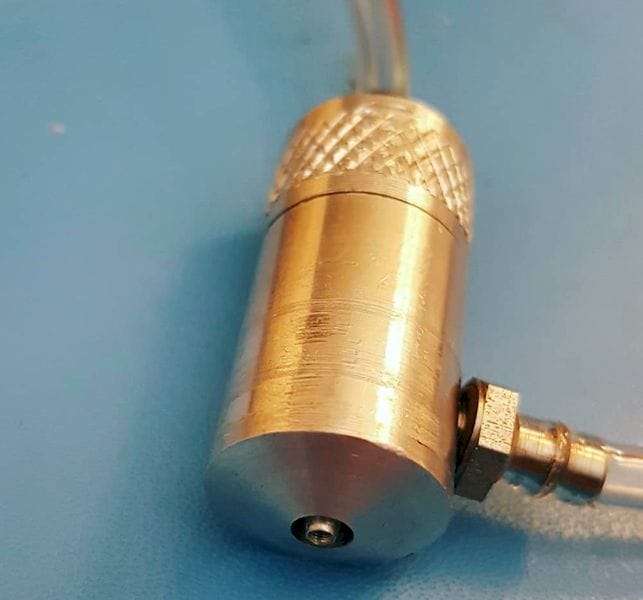![An unusual coaxial extrusion system for 3D printing of food [Source: 3D Digital Cooks]](https://fabbaloo.com/wp-content/uploads/2020/05/image-asset_img_5eb094069d97b.jpg)
I’m looking at a report on an experimental “coaxial extruder”.
The unusual component, devised by Luis Rodriguez Alcalde of 3D Digital Cooks, is intended for food 3D printing. But what is a “coaxial extruder”?
Essentially it is one nozzle inside of another. The idea is to extrude one type of material from a central nozzle, while a secondary material is extruded in an “O” shape around the central nozzle. This requires two separate mechanisms to push material to each of these coaxial nozzles.
Above we can see inside the nozzle, where you can see the inner and outer material paths.
Alcalde says:
“First lets explain properly what is a coaxial nozzle. It is as simple as a nozzle inside of another nozzle. This allows to ‘wrap’ a material with another. This would make sense for example to have a soft material inside and a ‘harder’ one outside that acts as a wall.”
How does it work? The nozzle, as seen at top, involves two separate feeders. Material for the central nozzle is delivered at the top, and material for the “O” nozzle is delivered to the side of the nozzle. The material must be fluid so that it can flow smoothly through the outer chamber to the exit. That secondary exit point is the “O” shaped void that surrounds the central nozzle.
Does it function? Here is a sample test made by Alcalde, who attempted to 3D print alternating blobs from each of the two nozzles:
![Sample food 3D print from a coaxial nozzle [Source: 3D Digital Cooks]](https://fabbaloo.com/wp-content/uploads/2020/05/image-asset_img_5eb09406e8fde.jpg)
As you can see, there is some leakage that causes the blobs to be polluted somewhat with material from the other nozzle.
![Inside a coaxial 3D print nozzle [Source: 3D Digital Cooks]](https://fabbaloo.com/wp-content/uploads/2020/05/image-asset_img_5eb094073f22e.jpg)
Coaxial Nozzle Software
Alcalde realized that the unusual structure of this nozzle would require some serious software engineering to ensure the unusual physical properties of the coaxial nozzle are accounted for. After testing with Greek yogurt, he says:
“This is the last test I do with the current coaxial nozzle. During the last experiments and design apps I have learn a lot about it. Now is time to let it sit and think about the next iteration!”
I’ve not seen this type of nozzle and extrusion system previously, but it is quite interesting. I suspect its use may be constrained to the food 3D printing market only, as it could be difficult to properly heat thermoplastics uniformly with the coaxial arrangement — where would you put the heater, for example?
![A delta 3D printer modified to use a coaxial nozzle [Source: 3D Digital Cooks]](https://fabbaloo.com/wp-content/uploads/2020/05/image-asset_img_5eb094077a8d8.jpg)
Coaxial Nozzle Jams
One big concern I would have with the coaxial system is what happens during faults? What if you had a jam in the outer nozzle? How could it be cleaned? That alone may disqualify its use for thermoplastics.
But it is good to see more experimentation taking place. To find the right solution, sometimes many have to be examined. This could be one of them.
Via 3D Digital Cooks











A Spanish company hopes to develop a specialized 3D printer that is capable of producing vegetarian steaks that both taste good and have great texture. But will you eat one?